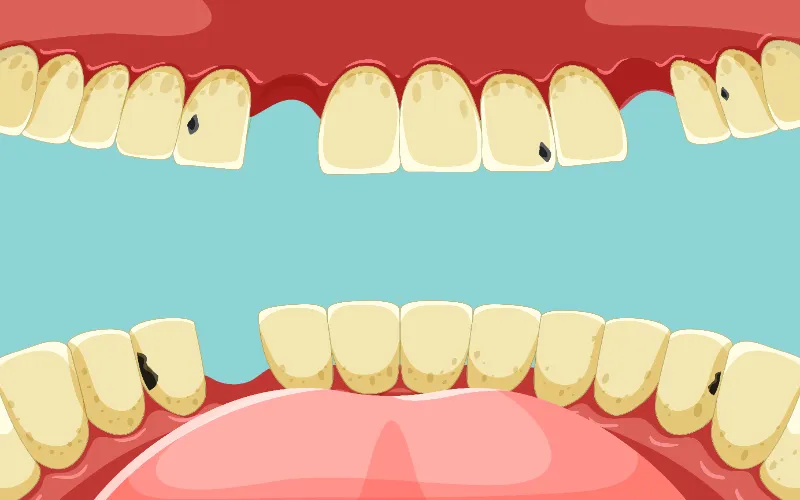Dental health is a cornerstone of overall well-being, with the front teeth playing a pivotal role in both aesthetics and functionality. Understanding the nuances of front teeth cavities is crucial for maintaining a healthy, radiant smile. This article delves into the anatomy of front teeth, the causes of cavities, early signs to watch for, and strategies for prevention and professional intervention.
Anatomy of Front Teeth
Front teeth, composed of a complex structure of enamel, serve as the aesthetic focal point of our smiles. The enamel, though resilient, is not impervious to the relentless assault of bacteria and dietary elements, making it susceptible to cavities.
Causes of Front Teeth Cavities
The primary culprits behind front teeth cavities are bacterial plaque and dietary habits. Bacteria produce acid that erodes enamel, while sugary substances act as fuel for these microbes. Recognizing this interplay is fundamental to preventing cavities from taking root.
- Bacterial Plaque Formation: Bacterial plaque, a thin film of microorganisms, adheres to the surface of front teeth. These bacteria metabolize sugars from food, producing acids as byproducts.
- Acid Erosion of Enamel: The acids generated by bacterial activity initiate a process of enamel erosion. Enamel, the protective outer layer of teeth, undergoes demineralization due to acid exposure.
- Sugary Substances as Microbial Fuel: Sugary substances in the diet serve as a potent energy source for oral bacteria. Bacteria ferment sugars, intensifying acid production and accelerating enamel breakdown.
- Interplay Between Bacteria and Enamel: The symbiotic relationship between bacteria and enamel creates a cycle of damage. As bacteria thrive on sugars, they perpetuate the acidic environment, further compromising enamel integrity.
Recognizing Early Signs
Early signs of front teeth cavities often manifest as sensitivity to hot or cold stimuli.
- Discomfort while consuming certain foods or beverages should raise a red flag, prompting individuals to seek timely intervention.
- Cavities may alter the color and texture of front teeth. Discoloration or the appearance of white spots can indicate enamel demineralization, signaling the need for proactive dental care.
- Individuals may experience discomfort or pain when consuming items with extreme temperatures, such as hot coffee or ice cream.
- Front teeth cavities can lead to heightened sensitivity, particularly when exposed to sweets, acidic foods, or even normal biting and chewing.
- Discoloration, ranging from subtle yellowing to more pronounced dark spots, can serve as a visible indicator of enamel degradation.
- Individuals might notice irregularities such as roughness or pitting, signaling the need for a closer examination by a dental professional.
- Enamel demineralization, a precursor to cavities, may manifest as the appearance of white spots on front teeth.
- White spots or discoloration serve as visible signs of enamel compromise.
- Recognizing these visual indicators empowers individuals to take timely action, preventing further progression of front teeth cavities.
- Early recognition of these signs is paramount for timely intervention and effective cavity management.
Impact on Aesthetics
Front teeth are central to our smiles, and any compromise in their appearance can significantly impact self-esteem and confidence. Cavities, if left unaddressed, can mar the aesthetic appeal of one’s smile.
The progression of cavities may lead to visible pits or holes in the affected teeth, further detracting from their natural beauty. Understanding the aesthetic consequences emphasizes the importance of preventive measures.
Functional Consequences
Front teeth play a vital role in proper speech and pronunciation. Cavities can alter the alignment and structure, potentially causing speech impediments and affecting oral communication.
Cavities, when left untreated, compromise the efficiency of chewing. This not only affects nutritional intake but can also lead to discomfort and pain while eating.
Prevention Strategies
- Proper oral hygiene is the first line of defense against front teeth cavities. Brushing with fluoride toothpaste using correct techniques and incorporating regular flossing into the routine can significantly reduce the risk of cavity formation.
- Limiting sugar intake is pivotal in cavity prevention. Opting for tooth-friendly foods, such as crunchy vegetables and fruits, can contribute to maintaining optimal dental health.
- Routine dental check-ups are imperative for early detection and prevention. Professional cleaning and examination can address concerns before they escalate, ensuring the longevity of front teeth health.
Treatment Options for Front Teeth Cavities
In the event of cavities, various treatment options, ranging from dental fillings to more advanced procedures, exist to restore the integrity and aesthetics of front teeth. Timely intervention is key to preserving both function and appearance.
Conclusion
In conclusion, front teeth cavities are not merely dental inconveniences; they have far-reaching effects on aesthetics and functionality. By understanding the anatomy, recognizing early signs, and adopting preventive measures, individuals can safeguard their radiant smiles. Regular dental care, coupled with professional intervention when necessary, forms the cornerstone of a holistic approach to dental health. Embracing these practices ensures that front teeth continue to be a source of confidence and well-being.

Dr. Orion Johnson is a dedicated and compassionate dentist committed to providing exceptional dental care to his patients.Dr. Johnson obtained his Doctor of Dental Surgery (DDS) degree from a prestigious dental school, where he excelled academically and clinically. He is licensed to practice dentistry and stays updated with the technology through continuing education and training.
